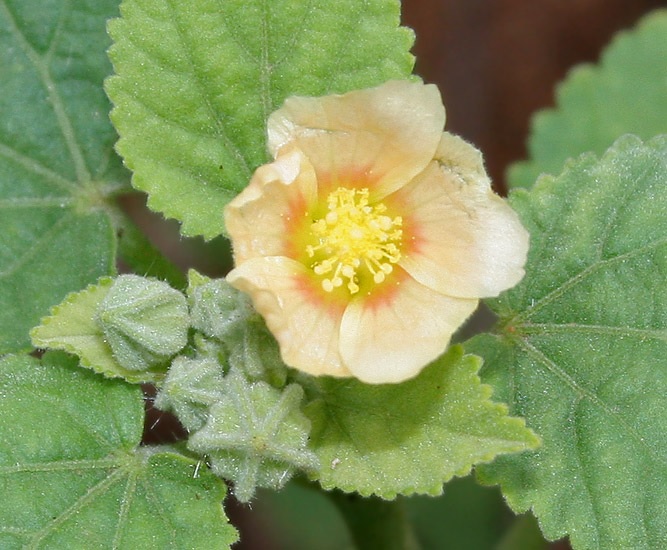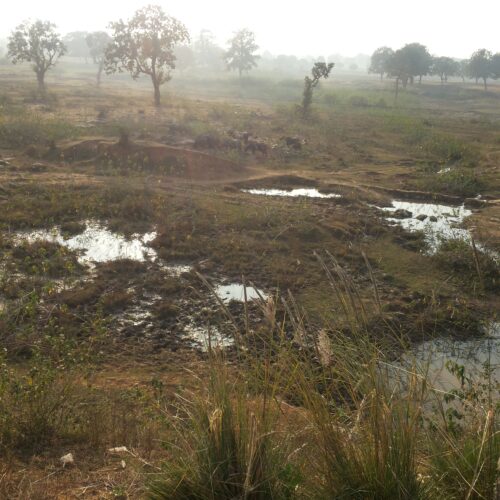Feature Image : en.wikipedia.org Sida cordifolia
Habit and Habitat
Sida is a shrubby plant which belongs to Malvaceae, a family of flowering plants. It grows in the wild in different types of habitats like overgrazed lands, roadsides; along the sides of walls of old buildings etc. It has a number of species many of which are native to India, America and other countries of the world. Sida cordifolia, S.rhombifolia, S.acuta etc. are some of its popularly known species.
Sida plant with a number of species is a perennial or annual sub-shrub or shrub growing 0.75 to 1.5 m in height.
Leaves are simple, stipulate, stipules threadlike to narrow lanceolate; the leaf base is entire or sometimes lobed with dentate margins.
Stem is cylindrical, branched, hairy, fibrous and deep green.
Roots of Sida are shallow tap roots, profusely branched and strong.
Flowers are solitary, or paired, axillary or sub terminal raceme or panicle. The plant flowers throughout the year. Calyx campanulate, or cup shaped, 5 lobed. Corolla is mostly yellow, rarely white or pink to purplish in colour. Sometimes the central portion is dark. Corolla has five petals of which all are free and basically connate. There is a filament tube in each flower which is pubescent or glabrous with many anthers at the apex. Ovary has five to ten locules. Each locule has one pendulous ovule ovules. Style has branches as many as the number of carpels. Stigma is capitates. Fruit is schizocarp.
Fruit is a ribbed capsule which breaks up into 8 to 10 segments. Seeds are smooth, gray to black in colour.
Distribution
Sida is a common weed which is distributed throughout tropical and sub-tropical India, Ceylon and America. It is distributed to New World Tropics and sub-tropics. Some taxonomists regard some species of Sida to be native to American countries. It grows in waste places, along railway tracks, in overgrazed lands, in jungles, in planes and even up to high altitudes.
Ethnoherbological Values
Prized for its medicinal properties in Ayurveda for over 5000 years, Sida plant is widely used in Indian alternative medicinal philosophy since the time immemorial. Ayurvedic physicians prescribed the decoction of Sida roots with ginger to cure intermittent fever. It is also administered in fever accompanied with rigour. Its seeds are called as Bijabanda in Ayurveda.
The powdered root bark is administered with milk and sugar as treatment for urinary urgency and leucorrhoea. Seeds are also used to treat urinary infections. They have been reported to be aphrodisiac also. The plant is reported to be well tolerated in routine doses.
Fresh extract of leaves of Sida is used in dropsy and chronic renal failure in a dose of 20ml, two to three times a day. Roots boiled in milk are used in a single daily dose for maintaining health. Paste of roots is used topically for treating inflammation.
Ayurvedic findings have revealed that the plant is aphrodisiac, analgesic, anti-inflammatory and tonic. It affects the central nervous system and provides relief from anxiety. Its extract is consumed to reduce body weight. It tones the blood pressure and improves the cardiac irregularity.
It is also useful in fever, fits, Ophthalmia, rheumatism, colic and nervous disorders. The extract of the whole plant is used in spermatorrhoea. Some scholars have reported that bark of the plant is effective in curing facial paralysis and sciatica. It has also been reported to improve sexual strength. Sida oils are used topically to the sore muscles and sore joints in rheumatism and arthritis. It is diaphoretic in nature and increases perspiration and helps in lowering fever.
The heart shape-leaved sida or the Sida cordifolia has three common applications in Ayurveda- mahabaladikwath, Bala taila, and astringent. Mahabaladikwath is prepared by mixing seeds of the plant with other ingredients, powdering and boiling the whole material and giving to the patient for relieving muscular pain.
Bala taila is used for the treatment of complaints of nervous system, stomach problems and as a cardiac tonic. Crushed leaves of the plant are used as astringent for the treatment and dressing of wounds or skin injuries.
Reports from surveys conducted in different regions reveal that sida acuta had many traditional usages that varied from regions to regions. The most popular use of sida acuta is made in the treatment of fever, headache, and infectious diseases. Many laboratory screening of the extract of the plant have also been done to show the scientific rationale behind these usages and many compounds have also been isolated from the plant.
It is due to its medicinal applications that it is cultivated in many parts of India. The powdered leaves of sida rhombifolia are used to relive swelling. Its fruits are used to cure headache. The mucilage of the plant is used as an emollient and the roots are used to treat rheumatism. Sida is traditionally used to treat diarrhea in Australia. In Mexico, leaves are smoked for its simulative effects. In some parts of India, sida leaves are used in tea for the same purpose.
The plant is traditionally being used as an astringent, antidote for scorpion stings and snake bites. Some traditional societies use this plant for the treatment of tuberculosis, chronic dysentery, nervous, urinary and cardiac diseases etc.
Medicinal Importance of Sida plant
Roots and stems of the plant contain ephedrine, an important alkaloid. Besides this, traces of sitosterol and palmic acid, stearic acid etc. have also been isolated from this plant. According to a report, main alkaloid present in sida is asparagin. Besides this fatty oil, phytosterol, mucin, potassium nitrate, resins and acids are also known to be found in the plant extract. It is also reported that sida does not contain any tannin or glycoside.
According to recent analysis, ephedrine and y-ephedrine are major alkaloids found in the aerial parts of the plant. Besides these two, some other chemical compounds that have been isolated from the aerial parts of sida are – 6-phenyl ethyl amine, carboxylated tryptomines, qunazoline, hypaphorine, vasicinol etc. Different species of this plant have been reported to contain cryptolepine also.
Sida has been reported to contain aphrodisiac, analgesic and anti-inflammatory properties. Its extract is reported to be a tonic in nature. It affects central nervous system and provides relief from anxiety. It is also used to reduce the body weight.
The intake of the extract of sida leaves is reported to lower the blood pressure and to improve the cardiac irregularity. However, contradictory reports have also been there. It is useful in fevers, fits, Ophthalmia, rheumatism, leucorrhoea, micturition, gonorrhea, colic, nervous disorders, and general debility.
The extract of roots of sida plant is useful in healing wounds. The extract of the whole plant is reported to be beneficial in spermatorrhoea. The bark of the stem is effective in sciatica and facial paralysis. The consumption of the juice of sida is reported to improve sexual strength.
The oil extracted from sida is used topically to sore muscles, sore joints, in arthritis and rheumatism. It is reported to be a diaphoretic in nature and to increase perspiration and thus it reduces fever.
According to a study, leaves of sida can be used as infusion in treating fevers and delirium. The roots of the plant are astringent and diuretic. Its infusion is useful in cystitis, haematuria, bleeding piles, chronic dysentery etc.
Sida is a shrub belonging to Malvaceae, a family of dicot flowering plants. Though a very important plant with great medicinal value, it grows and passes away without gaining due regard from men and animals. A field rat or a rabbit may rest under the shade of some of its shrubby species, or use it as a cover against enemies. Some insects though rarely, a lady bird may try to scrap and chew its leaves. Most of the cattle don’t try even to kiss this plant. Some of these appear as miniature trees.
Common names of Sida sp. –
Sida has a number of species. Some very common of these are – Sida cordifolia, Sida glabra, Sida spinosa, Sida rhombifolia, Sida urens etc.
Sida cordifolia L. syn. Melochiacordata, Sida humilis, Sida veronicifolia, is known as Country Mellow, Funnel weed, and heart leaf sida in English. In Japan it is known as ke dong. Nepalese call it Balu.Its Sanskrit name is Bala. In Spanish it is called as llima. Tamil people in India call it Chitaemuttie. Its names in other languages are- Bhumi Petari in Marathi, Kurunthotti in Tamil, Benda, gayapaku and Tirunala in Telugu; bekkinathale gida, in Kannad; Bhoybala in Gujrati; and Bhumibala, Naga bala in Sanskrit.
Sida glabra Mill is called as smooth fern petal in English; Balaicinq-heures in French, and Escobilla, Escobilladulce and Malva blanka in Spanish.
Sida spinosa L. is called as Valu in Nepalese and it is lesser known species.
Sida rhombifolia L. is native to the New World Tropics. It is also called as arrow-leaf sida, Cuban Jute, Paddy’s Lucerne, Queensland hemp, and Tea weed in English. In French it is called as Faux. In German it is called as Kubajute and in Nepalese it is called as Sannocilyaa. In Spanish Sida rhombifolia is called as Exoba, Escobilla, Escobitaceniza, Huinar, Malva prieta and Popotalagua.
Sida urens L. is called as Tropical fanpetal in English, and Khetri in Hindi. It is called as Marubakingo in Japanese, and Balai-zortie in French. It is known as Kedong in Chinese, Bala in Tibetan and Arival in Tamil.
Ecological value of Sida Plant
Sida has numerous species. Some are liked by herbivores but others are not, probably due to its ephedrine content. It usually grows in pastures competing with overgrazed grasses. Though an important medicinal plant, it is uncared in India. In some European countries, it is grown as fodder for deer. Some species of Sida are cultivated as fiber plant. Due to cleanliness drive in India it is now unavailable in most of the places especially along roadsides in rural and semi rural areas too.
Sida cordifolia, Ethnoherbological, medicinal values, Malvaceae, Schizocarp




